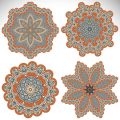Introduction to Haveli-Inspired Flooring
India’s rich architectural heritage is beautifully captured in the timeless charm of Havelis—grand traditional mansions known for their intricate details, spacious courtyards, and vibrant artistry. Rooted in centuries-old craftsmanship, Havelis reflect a unique blend of regional cultures and artistic expressions that continue to inspire contemporary home design across India. Today, the distinctive flooring styles seen in these historic homes are making a comeback, as homeowners look to infuse their living spaces with cultural depth and elegance. By incorporating elements such as patterned tiles, hand-crafted mosaics, and earthy natural stones, modern interiors pay homage to the regal ambiance and warmth of Indian Havelis. This resurgence not only preserves our artistic legacy but also connects us to our roots, allowing every step at home to echo with tradition and timeless beauty.
2. Popular Flooring Materials Used in Havelis
Traditional Indian havelis are renowned for their timeless elegance, largely attributed to the unique flooring materials used throughout these grand residences. These materials not only reflect the rich cultural heritage of India but also offer practical benefits and a warm, inviting ambiance for modern homes. Let’s explore some of the most popular flooring choices found in traditional havelis and understand how they infuse authentic Indian character into contemporary interiors.
Kota Stone: Enduring Beauty from Rajasthan
Kota stone, quarried from Rajasthan, is a staple in haveli flooring due to its durability and cool surface. Its natural blue-green hues lend an earthy sophistication to interiors, making it perfect for Indian summers. Kota stone is easy to maintain and can withstand heavy foot traffic, making it ideal for both heritage renovations and new builds inspired by haveli design.
Marble: The Symbol of Opulence
Marble has long been associated with luxury and grandeur in Indian architecture. Makrana marble, famously used in the Taj Mahal, is particularly popular in havelis. Its smooth texture and radiant white or creamy tones create a sense of spaciousness and elegance. Marble floors are often adorned with intricate inlays or colorful borders, echoing traditional Rajasthani artistry.
Terracotta: Rustic Warmth & Earthy Appeal
Terracotta tiles bring a rustic charm to haveli-style flooring. Made from natural clay, these tiles are hand-shaped and baked, resulting in unique textures and warm reddish-brown tones. Terracotta helps regulate indoor temperature and adds an organic touch that connects your home to nature—an important aspect of Indian living traditions.
Comparison of Traditional Haveli Flooring Materials
| Material | Origin | Main Features | Cultural Significance |
|---|---|---|---|
| Kota Stone | Rajasthan | Durable, cool, low maintenance | Common in Rajasthani havelis; symbolizes simplicity & strength |
| Marble (Makrana) | Rajasthan (Makrana) | Smooth, luxurious, brightens spaces | Represents opulence; seen in palaces & temples |
| Terracotta Tiles | Panjab, Gujarat, Bengal | Earthy tones, handmade textures, temperature regulation | Adds rustic warmth; reflects connection with earth |
Modern Adaptations for Today’s Homes
Many homeowners today blend these traditional materials with modern design sensibilities—pairing Kota stone with minimalist décor or using marble in geometric patterns for a contemporary twist. By choosing these timeless materials, you ensure your space is rooted in Indian tradition while enjoying the comfort and beauty suited for 21st-century living.

3. Intricate Patterns and Motifs
When you step into a traditional Indian Haveli, one of the first things that catches your eye is the mesmerizing beauty of its flooring. The floors are often adorned with intricate patterns and motifs that reflect centuries of Indian artistry and craftsmanship. Geometric patterns, such as repeating hexagons, diamonds, and interlocking shapes, are commonly used to symbolize harmony and balance. These designs are not only pleasing to the eye but also add depth and dimension to the space, making every corner feel thoughtfully curated.
Floral designs hold a special place in Haveli flooring. Inspired by India’s rich natural heritage, these motifs feature blooming lotuses, vines, and delicate petals—each element thoughtfully chosen to represent prosperity and renewal. These floral accents infuse a sense of freshness and grace, creating a welcoming atmosphere for family gatherings and festive occasions.
Another striking feature is the use of jaali-inspired motifs. Jaali work refers to the intricate lattice patterns traditionally seen in windows and screens of Havelis. When translated onto floors, these motifs create a play of light and shadow, adding an ethereal touch that elevates the regal ambiance of any room. By combining geometric precision with organic beauty, Haveli-inspired floorings capture the essence of Indian tradition while offering timeless elegance for modern homes.
4. Blending Traditional and Modern Elements
Indian homes today are a beautiful fusion of heritage and modernity, where traditional Haveli-inspired flooring can seamlessly blend with contemporary interior styles. Embracing this fusion creates living spaces that are both nostalgic and practical for diverse Indian lifestyles. Here are some helpful tips on achieving the perfect balance between age-old Haveli aesthetics and present-day design sensibilities:
Tips for Fusing Haveli Flooring with Modern Interiors
Traditional Element |
Modern Twist |
Practical Tip |
|---|---|---|
| Handcrafted Tiles (Mosaic, Encaustic) | Pair with Minimalist Furniture | Use neutral wall colours to highlight intricate floor patterns. |
| Natural Stone Floors (Marble, Kota, Jaisalmer) | Add Contemporary Rugs or Carpets | Layering a modern rug softens the look while maintaining traditional grandeur. |
| Geometric Patterns & Borders | Sleek Metallic or Glass Accents | Combine old-world patterns with sleek décor for a balanced ambience. |
| Inlay Work (Mother-of-pearl, Brass) | Contemporary Lighting Fixtures | Highlight inlaid floors with spotlights or pendant lamps. |
| Mud or Terracotta Tiles | Industrial or Boho Décor Styles | Create cozy corners with poufs, low seating, and lush plants. |
Adapting to Different Indian Lifestyles
- Nuclear Families: Opt for easy-to-maintain stone tiles in neutral shades combined with modular furniture for a chic yet traditional touch.
- Joint Families: Use durable marble or mosaic floors in living and dining areas, paired with classic wooden accents for warmth and longevity.
- Urban Apartments: Consider patterned vitrified tiles that mimic Haveli designs but offer modern durability and lower upkeep.
- Bungalows & Villas: Showcase grand floor medallions at entrances or courtyards to create a statement while keeping the rest of the décor streamlined.
Pro Tip: Harmonize Colour Palettes
Select flooring tones that complement your overall home palette. Earthy hues like ochre, deep reds, and indigos found in traditional Havelis pair beautifully with whites, greys, and pastels common in modern interiors. The right blend ensures your home feels inviting and timeless—a space where tradition meets today’s comfort.
5. Colour Palettes Inspired by Indian Heritage
When designing flooring inspired by traditional Indian Haveli styles, the choice of colour palette plays a crucial role in capturing the true spirit of Indian heritage. The timeless beauty of Havelis lies not only in their architectural details but also in their vibrant and earthy colours that reflect the warmth and richness of Indian culture. To create an authentic look, consider incorporating the following colour strategies into your flooring designs:
Earthy Hues for a Timeless Appeal
Start with earthy tones such as terracotta, ochre, burnt sienna, and warm browns. These shades have been used for centuries in Indian homes due to their natural origin and ability to ground a space. Earthy hues evoke a sense of rootedness and are perfect for creating a welcoming, cosy atmosphere reminiscent of old-world Havelis.
Jewel Tones to Capture Royal Grandeur
Infuse your flooring with jewel-inspired shades like deep emerald green, sapphire blue, ruby red, and amethyst purple. Such colours were commonly found in palatial Havelis and reflect India’s regal past. Use these vibrant tones as accents—perhaps in intricate tile work or borders—to add a touch of drama and luxury without overwhelming the space.
Natural Finishes for Authenticity
Embrace natural finishes such as hand-polished stone, unglazed ceramic tiles, or wooden textures. These materials not only bring out the organic beauty of traditional Indian floors but also help in keeping interiors cool—an important aspect in many parts of India. A matte or subtly glossed finish will ensure your flooring stays true to its roots while remaining practical for modern living.
Practical Tips for Harmonious Design
To achieve harmony, balance bold jewel tones with softer earth shades on the floor and throughout your interior décor. If you prefer understated elegance, let natural finishes dominate and introduce brighter colours through rugs or runners with traditional motifs like paisley or floral patterns. This layering technique ensures a cohesive look that celebrates both tradition and comfort.
Cultural Touches Make All the Difference
Remember, every region in India has its own distinct palette—consider Rajasthani reds, Gujarati indigos, or Kerala greens when selecting your hues. By thoughtfully combining these palettes with authentic finishes, you can create flooring designs that truly reflect the vibrancy and diversity of Indian heritage while making your home feel inviting and full of character.
6. Maintenance and Care Tips for Long-lasting Elegance
Maintaining the timeless beauty of Haveli-inspired flooring in the Indian climate requires thoughtful care and regular attention. Whether your floors are adorned with intricate marble inlays, classic terracotta tiles, or traditional Kota stone, proper maintenance ensures both elegance and durability for years to come.
Understanding Traditional Flooring Materials
Indian Haveli-style floors often use natural stones like marble, sandstone, and Kota, as well as hand-made tiles such as Athangudi or encaustic patterns. These materials are chosen not only for their visual appeal but also for their ability to keep interiors cool in India’s diverse weather conditions.
Daily Cleaning Practices
For daily cleaning, gently sweep or vacuum the floor to remove dust and debris. Use a soft, damp mop with mild, pH-neutral detergents suitable for stone or tile. Avoid harsh chemicals or acidic cleaners, as these can erode natural stone surfaces and fade vibrant tile patterns common in Haveli designs.
Protecting Against Humidity and Stains
India’s monsoon season can bring challenges like moisture seepage and fungal growth. Protect stone floors by ensuring proper sealing every couple of years. Wipe spills immediately—especially oils, turmeric, or tea—to prevent staining. For tiles, periodic regrouting helps maintain the integrity of joints and prevents water damage.
Preserving Aesthetic Details
Handcrafted inlays and intricate border designs are hallmarks of Haveli flooring. Avoid dragging heavy furniture across the floor to prevent scratches on delicate motifs. Use felt pads under chairs and tables, and place rugs in high-traffic areas to retain the original charm of your flooring.
Embracing Seasonal Care Routines
During summer months, allow rooms to ventilate well to minimize heat-related expansion or warping in traditional wooden flooring accents. In humid seasons, consider using dehumidifiers or silica gel sachets near corners to combat excess moisture—this is especially important in coastal regions of India.
A Blend of Tradition and Practicality
Caring for Haveli-inspired floors is not just about upkeep; it’s about honoring centuries-old craftsmanship while adapting to modern lifestyles. By following these maintenance tips tailored to Indian conditions, you ensure that your home remains a sanctuary of enduring beauty and functional elegance—just as Havelis have stood gracefully through generations.


